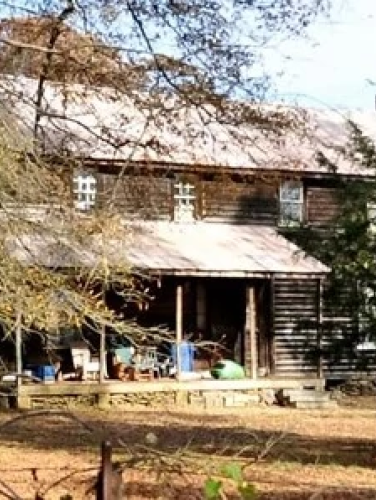
Cooper Log House
(ca. 1780s - 1790s)
The William Cooper family resided in the eighteenth-century Cooper Log House for nearly a century.
5621 Mt Olive Church Rd, Charlotte, NC 28278
The Cooper Log House is one of Mecklenburg County’s last remaining eighteenth-century structures. The house was likely built by William Cooper (1758-1834) sometime during the 1780s or 1790s. William was the son of John Cooper (1721-1801), a pioneer settler of the Steele Creek area. That section of Mecklenburg County began to be settled around 1751 and is believed to have been named after Robert Steele, a trader with the Catawba Indians. By about 1760, the predominantly Scotch-Irish settlers had organized the Steele Creek Presbyterian Church, where five generations of the Cooper family are buried along with many of the area’s other pioneer families.
Property Quick Links
County records suggest that John Cooper acquired some 336 acres in the Steele Creek area in 1767 and 1768. The original 1767 purchase was from George Augustus Selwyn (1719-1791), an English gentleman and member of Parliament, whose father John Selwyn received from King George II in 1745 a tract of 100,000 acres between the Rocky and Catawba Rivers. William Cooper apparently inherited all or part of his father’s Steele Creek properties and then purchased an additional 364 acres in 1782, 1785, and 1803.
Unlike his father, who apparently did not use enslaved labor, William acquired as many as nine enslaved persons between 1800 and 1834 – all aged between ten and twenty-four years old, except for three children under age ten – to work his substantial landholdings. They likely cultivated cotton, corn, wheat, hay, and oats, while also raising livestock. Upon his death, Williams’s lands and enslaved persons were divided among his children and grandchildren. William’s son Alexander Cooper (1798-1863) inherited the land that included the Cooper Log House and continued his father’s reliance upon enslaved labor. By the time of his 1863 death, Alexander enslaved at least nineteen people.
It was probably during Alexander’s ownership that the first addition to the Cooper Log House was made, circa 1840. As one faces the original log structure, that addition is the right-hand section. While carrying on the family farming tradition, Alexander ultimately acquired an additional 350 acres. His son Thomas Sandifer Cooper (1840-1904) was the last of the Cooper family to own the Cooper Log House. Thomas received the house and two enslaved young men from his father’s estate. Because the 1860 U.S. Census was the last census completed before the abolition of slavery, it is unclear whether Thomas owned any additional enslaved persons. Thomas served as Mecklenburg County sheriff from about 1887 to 1898. He also owned an interest in the Cooper and Lewis furniture company. Thomas added a second addition to the Cooper House – extending northeast from the rear of the original cabin – in about 1880.
In 1897, Thomas sold the house to Joseph A. Freeman (1859-1925) as part of a 161-acre tract of land. Freeman lost the property in a 1928 foreclosure that started a series of sales of the property that resulted in its ultimate reduction to a six-acre parcel.

